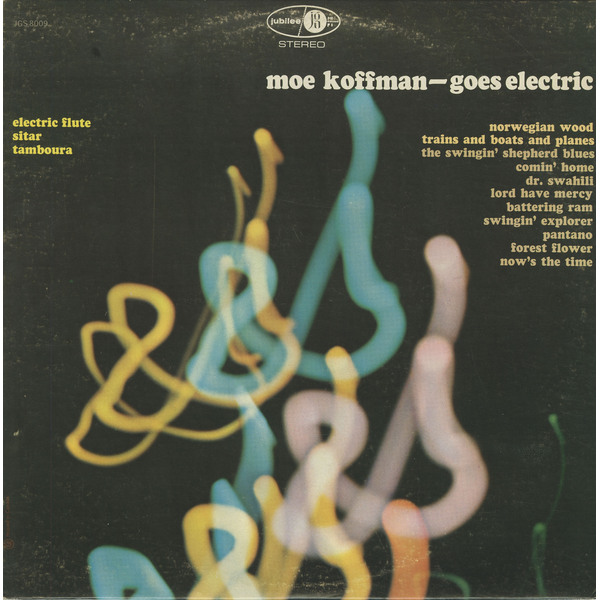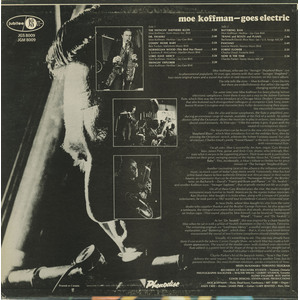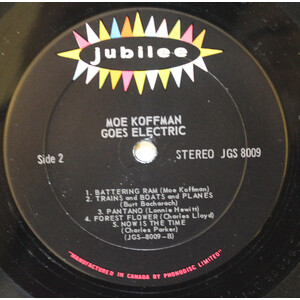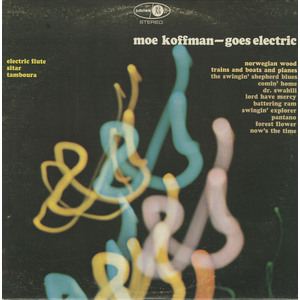Information/Write-up
Moe Koffman, who saw his “Swingin’ Shepherd Blues” rise to phenomenal popularity 10 years ago, returns with that same “Swingin’ Shepherd”, four more original tunes and a sound that takes in new musical territory on this latest album.
The title tells the story – Moe Koffman – Goes Electric but there are embellishments that reflect the rapidly changing world of music.
For some time now Moe Koffman has been playing Selmer electronic saxophones. From there it was just a step to the Selmer Varitone flute, which Moe was the first to introduce at a Chicago Music Dealers' Convention that also featured such distinguished colleagues as trumpeter Clark Terry, trombonist Warren Covington and clarinetist Jerry Fuller demonstrating their respective electrified instruments.
Like the alto and tenor saxophones, the flute is amplified, producing an enormous range of sounds, available at the flick of a switch. An added device called the Octamatic allows the musician to play in octaves; two tones produced simultaneously. As Moe says: “I like the variety it gets. It goes with the sound of contemporary music.”
The total effect can be heard in the new electrified “Swingin’ Shepherd Blues”, which Moe introduces first on the ordinary flute, then by pressing the Octamatic switch, achieves the Selmer Varitone sound. For sake of contrast, Charles Lloyd’s pretty “Forest Flower” is the only number played with conventional flute.
On all sides, Moe is assisted by Art Ayre, organ; Gary Binsted, bass; James Pirie, guitar, and Andy Cree, drums, who strikingly illustrate what it means to be supporting players. Their team work is particularly evident on their great, swinging version of the Herbie Mann hit, “Comin’ Home Baby”. This, incidentally, is Moe’s tribute to Herbie for his great version of “The Swingin’ Shepherd Blues”.
Another fascinating facet of this album is the influence of exotic music, so much a part of today’s pop-music world. Fortunately, Moe has had a first-hand chance to hear authentic Oriental and African music in their native haunts, an experience that can be discerned in “Norwegian Wood”, the Beatles’ tune; on Bacharach–David’s “Trains and Boats and Planes”, in “Dr. Swahili”, and another Koffman tune, “Swingin’ Explorer”, that originally started out life as a jingle.
On all of these Gary Binsted plays the sitar, the multi-stringed instrument made familiar to North Americans by the master Indian musician, Ravi Shankar. Moe bought it in India when, along with a troupe of Canadian entertainers, he took part in a 1967 world tour to celebrate Canada’s centennial year.
In New Delhi, where Moe bought his sitar from the same dealer who supplies Shankar and the Beatles’ George Harrison, he also acquired a tamboura, the stringed instrument that produces that steady, droning background on Indian ragas. (That sound, played by Moe himself, can be heard on “Norwegian Wood”, “Trains” and “Dr. Swahili”).
As for “Dr. Swahili”, this was inspired by a chant heard by Moe when he sat in with a group of Swahili drummers in Dar-Es-Salaam, Tanzania. The remaining originals are “Lord Have Mercy”, a soulful swinger that needs no explanation, and “Battering Ram”, which does – that is, if you have never before encountered the sound of two Varitone saxophones played simultaneously.
Visually, it’s something to see. This you may already have done if you watch the Johnny Carson Tonight Show, on which Moe has made a half-dozen appearances. The sound of the double saxes (with dubbed-over electrified flute added) is a potent hint of the shape of things to come. It’s straight out of Marshall McLuhan’s electrified world of the sixties.
Charlie Parker’s hit of the boppish forties, “Now’s The Time” delivers the same impact. The tune may date back to another Time, but its present rendition, like most Koffman creations, speaks completely of Now.
-Helen McNamara, Toronto Telegram
Moe Koffman: flute, dual saxophones, tamboura
Art Ayre: organ
Andy Cree: drums
Gary Binsted: bass, sitar
James Pirie: guitar
Engineered by Ron Snyder
Recorded at Hallmark Studios, Toronto, Ontario
Cover design by Steven-Craig Productions
Photographs by Blackliner – Walter Shean / Gilbert Studios, Toronto, Ontario





No Comments